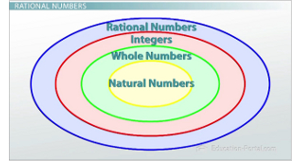What are the Different Types of Numbers?
Learn all of the different types of numbers: natural numbers, whole numbers, integers, rational numbers, irrational numbers, and real numbers. This video lesson teaches you how to classify any numbers you come across.
Natural Numbers
This is a lesson on the different classifications of numbers, which is basically a big word for just saying that numbers are part of families and numbers have different homes depending on what kind of number they are, just like people do.
I'll start by talking about myself a little bit. A lot of the time when I meet someone new, they ask me where I live. You don't give them your specific address. I don't tell them 202 Calvert Drive; that doesn't really mean much. But I do tell them that I live in Cupertino. That's probably the most specific name I use to describe where I live.
On the numbers side of things, the most basic number is the number 1, and the most specific descriptor of where it lives is called the natural numbers. The natural numbers are all the numbers that you learn when you're a baby, like 1, 2, 3, 4, 5, 6 and on and on. The natural numbers are also sometimes called the counting numbers because they're the first numbers you learn how to count.
Whole Numbers
Back to me real fast, although I do live in Cupertino, Cupertino is part of Santa Clara County. This means that since I'm a resident of Cupertino, I'm also a resident of Santa Clara County. But the reverse isn't necessarily true, because not everyone that lives in Santa Clara County lives in Cupertino, so you have to be careful going back and forth.
Numbers are the exact same way. If we get a tiny bit less specific, what we come to are called the whole numbers. All of the natural numbers are part of the whole numbers, just like all the people who live in Cupertino also live in Santa Clara County. But there is one whole number that is not a natural number. That is the number 0. So when we're talking about the whole numbers, we're talking about the numbers that start with 0 and starting going up 1, 2, 3 and on and on.

Diagram showing the difference between natural numbers and whole numbers
Integers
Taking a step further back in my situation, Cupertino and Santa Clara County are both parts of California. Again, not everyone that lives in California lives in Santa Clara or, even more specifically, Cupertino. But if you live in Cupertino or Santa Clara, you're definitely living in California.
Taking a step out in terms of the numbers brings us to what are called the integers. Again, not all of the integers are whole numbers and natural numbers. But all of the whole numbers and natural numbers are integers. The integers now also add in the negatives: -1, -2, -3 and on and on in the negative direction as well.
Rational Numbers
Taking another step back with me, I think most people are aware that California is a state that is part of the U.S. So I am also a resident of the United States. Again, everyone that is a resident of California is also a resident of the U.S. But not everyone that lives in the U.S. lives in California.
That trend continues with the numbers. As we take another step back, we come to what are called the rational numbers. The new additions to the club are fractions. This means we could have things like -1/2 or 1/3 or 3/4 or maybe 11/7.
The list becomes a little bit harder to write but, again, you could imagine that there are a lot of different kinds of numbers in here. It's still true that all of the previous numbers we mentioned are rationals, but not all of the rationals, specifically these fractions, are part of the numbers in the integers, whole numbers or natural numbers.
